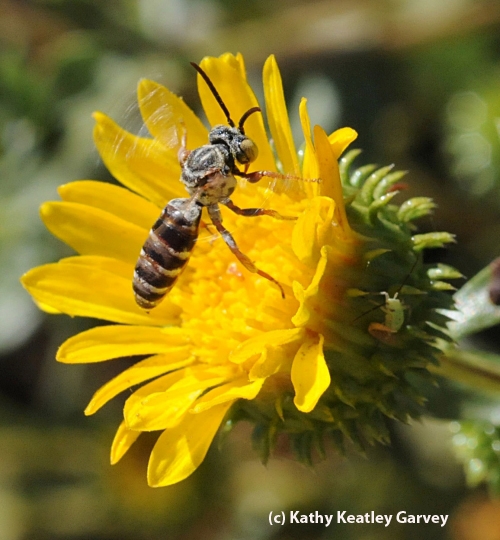Chances are if you walked up to a group of people and asked "Have you seen a Megachile today?" they'd stare at you blankly.
What's a Megachile? It's a native bee, also known as a leafcutter bee.
When most people think about bees, they think about honey bees, which are native to Europe.
They don't think of the some 4000 bee species native to the United States. Of that number, about 1600 species are found in California.
Enter Jaime Pawelek of UC Berkeley's Department of Organisms and the Environment, a researcher who works in professor Gordon Frankie's lab. She discussed “Native California Bees: Looking for Cheap Urban Real Estate” at the Nov. 6 meeting of the Northern California Entomology Society meeting in Concord.
The "real estate," as Frankie related earlier in an e-mail, "refers mostly to the flowers that people use in their gardens."
Pawelek, who received her bachelor of science degree in conservation and resource studies from UC Berkeley, showed slides of numerous native bees, including a metallic green bee (Agapostemon texanus), long-horned bees (Melissodes sp), yellow-faced bee (Hylaeus sp.), leafcutting bee (Megachile sp.), and a yellow-faced bumble bee (Bombus spp.), not to mention the sweat, squash and orchid bees.
Most native bees (in fact, more than 70 percent) nest in the ground, Pawelek said. And, most native bees are solitary nesters. Some native bees are as tiny as a grain of rice.
Native bees are adept at pollinating specific crops, including blueberries, tomatoes and alfalfa, Pawelek said.
What should concern us: the decline in the diversity and abundance of native bees. "Causes for the decline may include," she said, "pesticide use, habitat destruction and fragmentation, and global climate change."
Although past studies have focused on agricultural or wildland habits, urban areas can also serve as habitat of native bees. In fact, initial research by the Gordon Frankie lab found 82 bee species in Berkeley alone, and of that number, 78 were native bee species.
In 2003, the Frankie lab set up the Oxford Tract Experimental Garden in Berkeley with a main goal of monitoring the diversity and abundance of bee species visiting an urban garden, Pawelek said.
In 2003 they planted some 16 species, including sunflowers, cosmos and sage. In 2005, the garden contained 40 plant species. Today it's swelled to more than 130 plant species.
To date, the researchers have collected a total of 37 bee species in the experimental garden alone. Native pollinator specialist Robbin Thorp, emeritus professor, UC Davis, identifies them. "He's our bee taxonomist," Pawelek said.
In monitoring the bee-plant associations--now a primary component of their research--they found that native bees forage at native plants more often than non-native plant species, and certain plant families are highly attractive to bees. These include Asteracae (aster family), Lamiaceae (mint family) and Polygonaceae (knotweed family).
Their research takes them to urban diversity sites throughout California. Some sites are community gardens, residential gardens and neighborhood parks. Others: cemeteries and weedy lots.
Information collected at each site includes bee abundance and diversity, bee species identification, bee-plant associations, seasonality of bees and plant resources.
If you want to plant a bee friendly garden, here are some tips. It's important to offer diversity--include at least 20 plant species, Pawelek said. Cluster flowers of the same species in the same patch. Be sure to leave bare dirt for nesting purposes (unlike gardeners, bees don't like mulch). Also, provide wood blocks for cavity nesters. To make a "bee condo," drill holes of various sizes in untreated wood.
You may also want to consider what California Academy of Sciences did: a roof-top garden. The academy maintains a "green roof" using many native California bee plants.
If you'd like to design an urban bee garden or just want to know more about native bees and what flowers to plant, check out Frankie's comprehensive and exceedingly well done Web site.
Better yet, bookmark it! It's a winner!
Attached Images:
